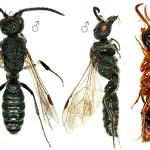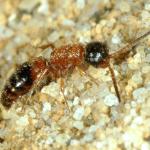British specimens of the wingless females have black heads, whereas, in Ireland and the Isle of Man, the females have red heads (Stelfox, 1933;Yarrow, 1954a). All males are winged and have black heads. Identification keys are given by Richards (1980) and Yeo & Corbet (1995).
Found throughout England and Wales including the Isle of Man and the Channel Islands, but not yet found in Scotland. Recorded widely in southern Ireland, and in addition to the information shown on the map, it has also been reported from County Tipperary (Stelfox, 1933).
Overseas, found in many parts of Europe (The Netherlands, Belgium, France, Spain, Germany, Switzerland, Italy, Poland, former Czechoslovakia, Austria, former Yugoslavia and Estonia) and in Asia (Iran and Siberia).
This species is not regarded as being scarce or threatened.
Associated particularly with sandy places; also on chalky banks, slopes in woods and roadsides.
Sometimes, one sees the males skimming over the soil surface and the females running about on the bare soil around the nesting sites of its hosts. Males can be found very commonly in Malaise traps (M Edwards, pers. comm.)
Males are found on flowers of bramble and umbellifers such as wild carrot and wild parsnip.
No information available.
1998



